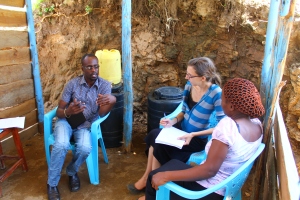
Photo by: April Parsons
Laura Fisher, with translation help from Uthman, surveys a patient at a health center.
“We really should be working in all 69 of these health centers,” said Kissito President Tom Clarke one night, during a casual conversation at the Ugandan volunteer house. It was a simple statement that brought about one of the biggest tasks the KHI research team has ever taken on.
We knew they needed the help, and we knew we had help to give, but what were the specifics? That is what our key researchers Laura Fisher, and Doug Dasilva, have set out to find. Instead of just giving out goodie bags of gauze and gloves, or placing incubators in random facilities, the research team will be going into all 69 facilities in the Mbale, Manafwa and Baduda districts to find out what each facility needs; everything from the types of drugs, and supplies, to water and electricity, and to possible improvements on staff and patient satisfaction.
After a lot of hard work, literature reviews, and discussions with doctors they created a three-tier comprehensive study. The first part is a massive survey, 747 questions to be exact, that asks about every single drug, supply or piece of equipment that a health center would have. The second is health worker surveys, which get both qualitative and quantitative data; how often to they work, what do they need to better perform their job etc. The third is patient satisfaction surveys. They ask the patients about their experience at the health center; whether they knew what their diagnosis was, or when to take their medicine.
It’s been about two months and the research team is not even half way done with the baseline. Most facilities take anywhere from one to two hours to get to, and you could never complete the surveys at more than two health centers in a day (and that doesn’t include the document organizing or data entry!).
So far they have completed the entire Baduda district, and half of the Manafwa district. Although they have a long way to go, some of the statistics they have found already are quite surprising, and really tell a tale of just how much work we have cut out for us.
Data below is from 25 facilities – 4 Hospitals/Health center 4s, 11 health center 3s, and 10 health center 2s:
12% have running water from the city.
Only 60% have a functioning water tank.
That means 40% percent of facilities do not have water.
80% of facilities do not have electricity.
40% do not have nutrition patient education services
20% do not have a thermometer.
12% do not have a stethoscope.
76% do not have a measuring tape for height.
And only 24% of health facilities have access to an ambulance.
This is just the beginning of their assessment. They hope to have the surveys completed by the end of April and will then be able to give completely accurate statistics for the eastern region of Uganda.
Don’t forget to subscribe to our blog! And make sure to stay up-to-date with the research team, as well as the rest of our volunteers on Facebook and Twitter!.
